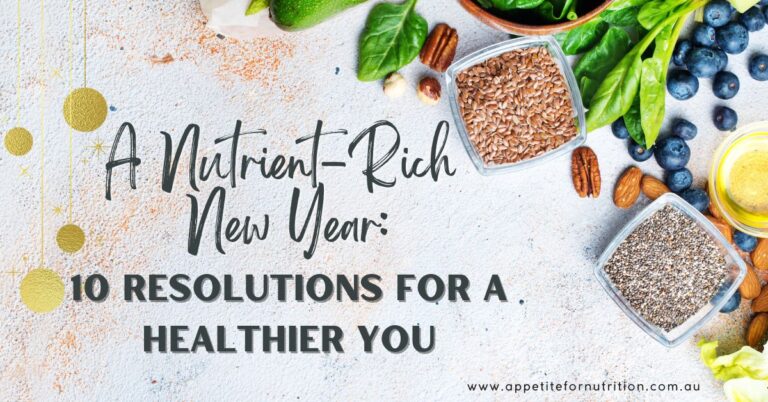
Healthy Eating During Easter
Welcome to a Healthy and Happy Easter
Easter is a time filled with traditions, family gatherings, and — of course — plenty of chocolate!
While celebrations may look different year to year, the joy of sharing food and connection remains the same.
At Appetite for Nutrition, our dietitians know that holidays can challenge even the healthiest routines. The good news? You can enjoy festive treats without guilt by making mindful, balanced choices. Here’s how.
1. Don’t Deprive Yourself
It’s Easter — chocolate is part of the fun! Instead of avoiding it altogether, enjoy your favourite treats in moderation. Restriction often leads to overindulgence later.
Try choosing a few high-quality chocolates you truly enjoy and savour them slowly to stay satisfied and guilt-free.
Read more: Tips to Beat Late-Night Snacking and Mindless Eating
2. Stay Hydrated
Amid hot cross buns and Easter eggs, hydration can be forgotten. Water helps maintain energy, aid digestion, and support overall wellbeing.
Aim for water between other drinks and meals — especially if you’re enjoying alcohol or sweet beverages.
3. Keep Active
Balance festive eating with movement. Whether it’s a morning walk, family garden games, or stretching indoors, physical activity helps digestion and boosts your mood.
Even 10–15 minutes of movement can make a difference.
4. Start the Day Right
Begin Easter morning with a nutritious, filling breakfast to stabilise blood sugar and prevent cravings later.
Try:
Oatmeal with fruit and nuts
Wholegrain toast with avocado or eggs
Greek yoghurt with berries and chia
5. Choose Dark Chocolate
When selecting your Easter eggs, go for dark chocolate (70% cocoa or higher). It contains antioxidants and less sugar than milk chocolate, offering a more satisfying and nourishing treat.
6. Practice Portion Control
Chocolate bunnies and eggs are easy to overeat. Divide larger eggs into smaller pieces or share them with family.
Keeping portions smaller helps manage energy intake while still enjoying your favourites.
Dietitian tip: Try pairing chocolate with fresh fruit or nuts for extra nutrients and balance.
7. Add Vegetables to Every Meal
Roasted veggies like carrots, Brussels sprouts, pumpkin, or beans help add fibre, vitamins, and colour to your Easter feast.
Filling half your plate with vegetables keeps meals balanced and helps you feel satisfied without overeating.
8. Lighten Up Your Recipes
Small recipe swaps can make big differences. Try:
Using applesauce instead of oil in baking
Choosing lighter sauces or yoghurt dressings
Flavouring meals with herbs, spices, or lemon instead of salt
Check out our Healthy Recipe Blog Series for more creative swaps.
Quick Health Facts to Remember
Hydration: Water supports digestion, energy, and appetite control — especially important if enjoying wine or sugary drinks.
Movement: Regular activity boosts mood and metabolism while balancing extra calories.
Nutrient Timing: A healthy breakfast sets the tone for smarter choices throughout the day.
Post-Easter Reset: Resume your normal meal routine and hydration the next day — no “detox” needed!
Conclusion
Easter is meant to be enjoyed — food, family, and all!
By planning ahead and practicing mindfulness, you can celebrate with balance and joy. Remember, moderation and self-compassion go hand in hand with long-term wellbeing.
Explore next:
Ready to Feel Your Best This Easter and Beyond?
If festive eating, portion balance, or food guilt have been holding you back, our Accredited Practising Dietitians can help you build confidence around food.
We offer both general nutrition consults and specialised dietitian support (Bariatrics, Women’s Health, Feeding Therapy, Eating Disorders, Gut Health, Sports Nutrition) available online and in person across Brisbane, Gold Coast, Melbourne, Shepparton, Bendigo and Albury-Wodonga.
Contact Appetite for Nutrition today to create a plan that helps you eat well, enjoy food, and feel great.
This blog was updated October 2025.
Frequency Asked Questions
Find quick answers to common questions
Our team of NDIS-registered dietitians helps clients make practical, evidence-based food decisions that fit their goals, lifestyle, and budget.
Yes, in moderation. Enjoying a small portion daily is fine — just balance it with nutritious meals and activity.
Dark chocolate (70% cocoa or more) contains less sugar and more antioxidants than milk or white chocolate.
Resume your normal routine the next day. There’s no need to “detox” — your body naturally rebalances with hydration and healthy meals.



